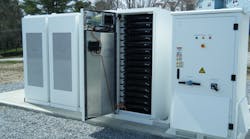This topic was brought to my attention when a representative from Underwriter’s Laboratories (UL) answered a question in the July/August issue of IAEI magazine. Here’s the question as it appeared in that edition.
“We are using the 2017 National Electrical Code (NEC) in my jurisdiction and are encountering installers using certified (listed) photovoltaic (PV) inverters combined with lithium-ion batteries to create an energy storage system (ESS) in the field in accordance with NEC 706.4(2) and (3). Can a PV inverter be used as part of an assembly of certified (listed) components to form a battery energy storage system in the field?”
The answer and explanation were lengthy, but the first paragraph read as follows:
“No, that would be a violation of NEC 110.3(B) and may present considerable fire and electric shock hazards without further investigation of an inverter’s compatibility with the battery bank and battery management system for compliance with UL 9540, the Standard for Safety of Energy Storage Systems and Equipment.” [Read the full response on pages 32-33].
My response to this question would normally be “yes,” but there are now some issues to be considered when looking at this type of installation.
The change
The 2017 edition of the NEC is not the focus here but rather UL Product Standard 9540, the standard for safety of energy storage systems and equipment. Article 706 of the NEC provides the requirements for the installation of ESSs and their associated equipment. The definition of an ESS as written in the 2017 NEC is:
“Energy Storage System (ESS). One or more components assembled together capable of storing energy for use at a future time. ESS(s) can include but is not limited to batteries, capacitors, and kinetic energy devices (e.g., flywheels and compressed air). These systems can have AC or DC output for utilization and can include inverters and converters to change stored energy into electrical energy.”
However, this definition was changed in the 2020 NEC. Now it reads as follows:
“One or more components assembled together capable of storing energy and providing electrical energy into the premises wiring system or an electric power production and distribution network.”
Some of the other information is now covered by an Informational Note. This is where the change creates a severe impact on the energy storage industry. In the 2017 NEC, there are three other definitions associated with energy storage systems. They read as follows:
“Energy Storage System, Self-Contained. Energy storage systems where the components such as cells, batteries, or modules and any necessary controls, ventilation, illumination, fire suppression, or alarm systems are assembled, installed, and packaged into a singular energy storage container or unit.”
Informational Note: Self-contained systems will generally be manufactured by a single entity, tested and listed to safety standards relevant to the system, and readily connected on site to the electrical system and in the case of multiple systems to each other.
“Energy Storage System, Pre-Engineered of Matched Components. Energy storage systems that are not self-contained systems but instead are pre-engineered and field-assembled using separate components supplied as a system by a singular entity that are matched and intended to be assembled as an energy storage system at the system installation site.”
Informational Note: Pre-engineered systems of matched components for field assembly as a system will generally be designed by a single entity and comprised of components that are tested and listed separately or as an assembly.
“Energy Storage System, Other. Energy storage systems that are not self-contained or pre-engineered systems of matched components but instead are composed of individual components assembled as a system.”
Informational Note: Other systems will generally be comprised of different components combined on site to create an ESS. Those components would generally be tested and listed to safety standards relevant to the application.
Section 706.5 in the 2017 NEC simply requires the various elements of an energy storage system to be listed (other than lead-acid batteries), and it requires complete systems to be listed as an assembly.
These systems have been built in the field for many years with little or no quantified failures — at least none that were submitted during the 2020 NEC revision cycle. In fact, I’ve seen many installations where a PV system has been installed with a multimode inverter and no energy storage equipment installed at that time. The owners of these systems would then have an installer come back at a later point in time, install the energy storage equipment, and connect it to the existing inverter. I’ve also inspected many systems where the inverter manufacturer and the energy storage equipment manufacturer were not one in the same — and through the manufacturer’s instructions for both allowed for their interconnection following proper safety requirements as defined in their installation instructions and requirements in the NEC.
Call for further discussion
I believe the response provided by UL to the initial question, based on the 2017 NEC, should be open for further discussion as it really depends on the equipment and its installation instructions, as well as its listing for the intended application.
The 2017 NEC clearly allows field construction of multiple listed components for these systems. However, that changed in the 2020 NEC based on a Public Comment (PC) #1572 submitted by a representative from a testing laboratory. The change mandates that all ESSs must be listed as a system and removes the option to field-assemble listed components from different manufacturers unless those components have been submitted as an assembly for testing to the requirements set forth in UL 9540.
This change really needs more public review, and hopefully the affected industries will use the NFPA system to drive further discussion on this important issue.
Rogers is the owner/operator of Bay State Inspectional Agency, Vineyard Haven, Mass. He is an active instructor for IAEI, the wiring inspector for the town of Oak Bluffs, and the chair of NEC Code-Making Panel 4. He can be reached at [email protected].






